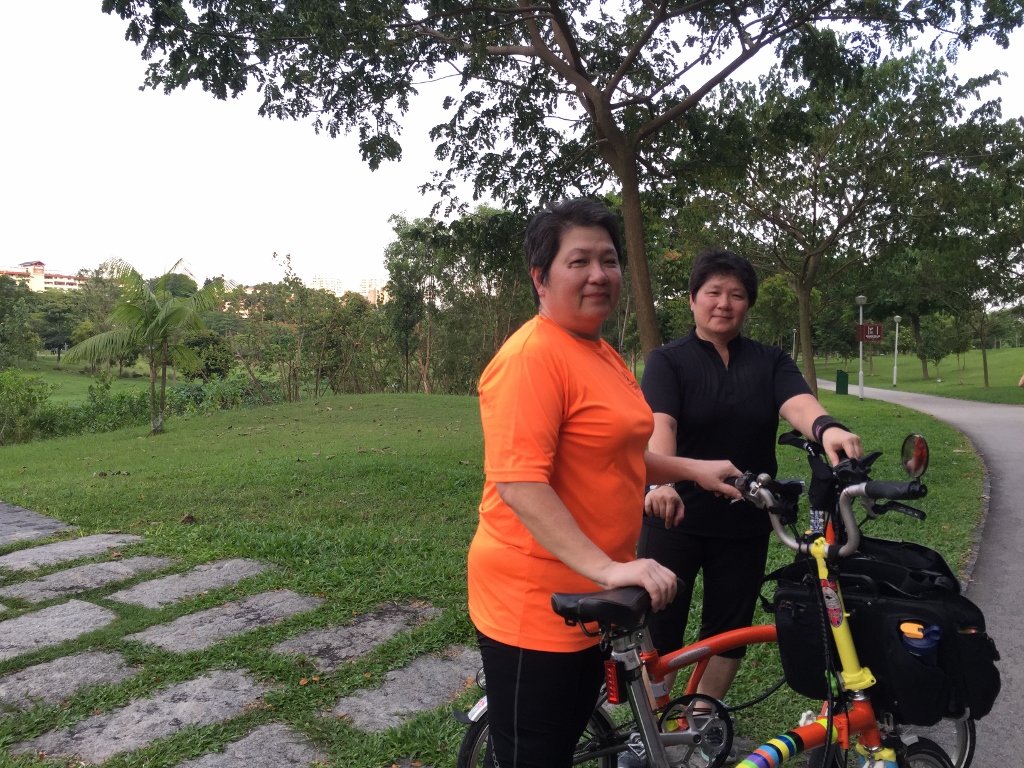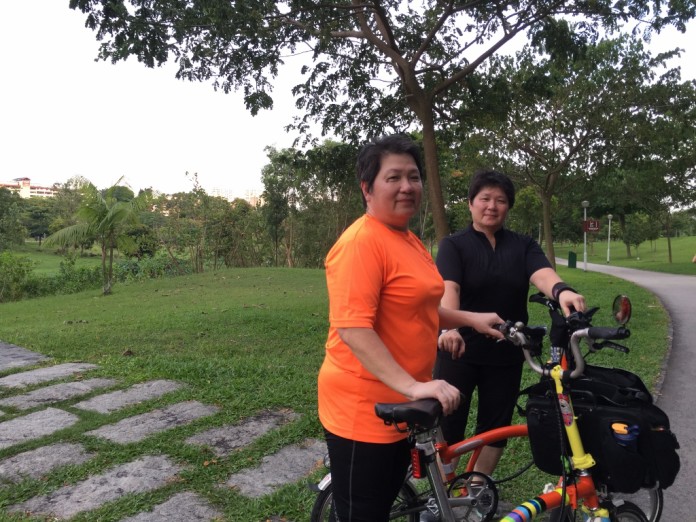SINGAPORE: Twin sisters Woo Li Ling and Woo Li Shan jumped on the cycling bandwagon about five years ago after joining an online cycling group. Li Ling, 55, now says cycling is a constant in her life. She rides from her home in Toa Payoh to her Jurong East workplace every day, and takes her bike with her whenever she travels.
But Li Shan has not quite caught on yet. “I don’t cycle much mainly because of the traffic,” she said. “Usually I go on the bus lane because bus lane allows bicycles, but it’s not nice to occupy the bus lane when the buses are all behind me.”

Cycling enthusiasts Woo Li Ling and Woo Li Shan. (Photo: Kenneth Lim)
Still, both are in sync when it comes to what they would like the authorities to do to encourage people to give cycling a go.
“I first had a fear of cycling on the road because Singapore roads are so congested,” Li Ling said. “And although I ride everyday to work now, I start early, before the traffic becomes heavy. I’d like to have more PCN (park connector networks) along the roads, like what they have at Ang Mo Kio and Tampines.””
Ang Mo Kio is Singapore’s first “walking and cycling” town, launched in July 2016. A 4km cycling path loops around Ang Mo Kio Avenues 1, 3 and 8, taking residents to nearby amenities like the MRT station. The network will be the longest of any town once it is completed in 2019, authorities say, and give cyclists a direct route to the city.
The Ang Mo Kio initiative and others like it reflects Singapore’s desire to push its citizens to adopt public and alternative transport, with an emphasis on reducing car use. This comes even as the city-state grapples with an ageing rail network and land constraints, which affect its ability to build more car parks and roads.
According to the Land Transport Authority (LTA), every HDB town will have its own cycling network by 2030, including new HDB precincts and BTO projects, like Bidadari,Tampines North and the new BTO projects in Sembawang and Yishun. Cycling links in Bishan, Buangkok, Dakota, Dover, Potong Pasir, Woodlands, and Yew Tee are completed, while those in Clementi, Hougang, Marsiling, Promenade, and Sengkang will completed by end 2016.
“What we hope to see is really over the next 10 to 15 years, to see an increase in terms of uptake,” says LTA’s director of Active Mobility Tan Shin Gee. “It’s about 1.5 per cent of people who cycle in Singapore, so we hope to grow that three to four times.”
Ms Tan was citing a 2012 LTA large-scale household interview and travel survey done once every five years,focusing on commuters’ travel patterns. The next edition of the survey will be conducted next year.
Besides launching more cycling networks, Singapore will also join the ranks of cycling cities like New York and London next year with its first-ever bicycle-sharing program in the Jurong Lake District – which promises more than 1,000 bicycles and 100 docking stations. Such programs have “catalysed the uptake of cycling” in other cities, Ms Tan said.
USE OF PERSONAL MOBILITY DEVICES ON THE RISE
2016 has also seen more commuters use personal mobility devices like e-scooters and hoverboards on Singapore streets. In December, LTA embarked on a six-month trial, allowing people to take their devices on board trains and buses during peak hours for the very first time. Since then, LTA says it has seen 10 to 15 people do so at each station every day during the morning peak period.
“So far the numbers have not been large, but it’s something we will continue to monitor and as we go along perhaps adjust the rules of codes of conduct,” Ms Tan said.
For example, the new Active Mobility Act will be passed in Parliament next year – spelling out the speed limits, penalties, and other guideline for commuters using such devices.
But beyond the numbers, Ms Tan said the aim is “to see a change in terms of peoples’ openness to these active modes”.
“In the medium to long term you would regard walking or cycling or using these personal mobility devices as commonplace as hopping on a bus or a train,” Ms Tan says.
But besides making it easier to walk and cycle, one researcher says Singapore’s climate also needs to be taken into account.
“At the end of the day, it also means that it’s not just mere statistics that we say 80 per cent is within 10 minutes walk or households are within a 10-minute walk of train stations,” says CPG transport consultant Vincent Loh. “We need to ensure that walking is good, comfortable, should be able to attract someone on the sidelines desiring whether to own a car, to purchase a car or to take public transport. So if you make public transport really attractive, I think we could wean off some of this desire.”
Mr Loh’s work focuses, among others, on urban design – and making roads or neighbourhoods more accessible to pedestrians. He has proposed that authorities can turn more disused infrastructure, like the Rochor Canal, into linear parks – one way he says countries like Japan have made walking a way of life.
“I think certainly we are always on the lookout to see how we can make our infrastructure fit in better with the surroundings, appeal more to people,” Ms Tan said, when asked about Mr Loh’s proposals.
LTA aims to build about 150 kilometres more sheltered walkways by 2018. And from July this year, commercial developers must submit their plans complete with shelters and crossings for cyclists and pedestrians.
CAN WE KILL THE DRIVE TO … DRIVE?
But Mr Loh also says that it is one thing to make public transport more attractive. More steps are needed for Singapore to go car-lite.
“We need to still, I believe, have the other aspect, the other element of vehicle restraint,” he said. “I don’t think we can move away from that.”
Singapore was among the first cities to adopt vehicle restraint measures like electronic road pricing (ERP), and auctions for car quotas. Public car park rates have risen this year for the first time in 14 years, and Mr Loh said such policies are likely to continue.
“The issue is whether the provision of car park is at the expense of space for other users in the city and elsewhere,” he said.” At the end of the day we want to have more of this space to cater to the larger population which are going to use these facilities. “
But as many in the transport sector say -“car lite” doesn’t mean “car-less”, with shared cars still having to play a part in getting people from point to point.
To that end, Singapore’s first large-scale electric car-sharing programme will be launched in 2017, starting in towns like Ang Mo Kio, Jurong East and Punggol. Private hire companies like Uber and Grab have also come out with similar schemes.
But ultimately, those we spoke to say that a car-lite society is possible if Singaporeans takes that first step away from their cars, and shift their travelling habits.
“We hope that over time that beyond the infrastructure plans and the policies we have been changing over time, that we also have the support of the community to get this movement going,” Ms Tan said.
“As cyclists, we also have to be responsible,” added Ms Woo Li Ling. “If we are friendly to the drivers, to the motorists, they are friendly to us.”





